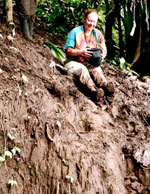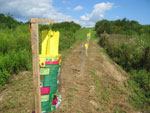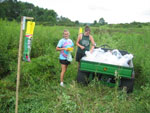Posted on Wednesday, September 20, 2006
This is a happy story of cooperation between the Field Station and a Westminster alumna, Doreen Hoover. Doreen lives in Spokane, Washington but her family home was in Smicksburg, PA, near the famed Punxsutawney Phil.
When college graduates look for jobs, they really want one that is challenging and comes within their area of concentration in college. That didn't happen directly for Doreen. . . but it did eventually. After finishing her B.S. degree in 2000 with a double major in environmental science and biology, she took a position that was somewhat, but distantly, related to her major. She became an Environmental Specialist as a food inspector for the Allegheny County Health Department. This meant checking restaurant kitchens and bathrooms, putting a thermometer into a hamburger and determining any violations of the code. She even had to shut down a restaurant! She survived that job for two years and then went on to a position in a company where she had worked as an intern after graduating from college. Doreen is now an Associate Scientist at Sterling International, Inc., Spokane, Washington (www.rescue.com).
I've had many visits with Doreen since she, as a student, spent time at the Field Station and in my classes. She also worked as a Teaching Assistant in the course titled Biodiversity that I taught to 20 students. Another time, following graduation, was as a fellow traveler to Ecuador in 2002. We trekked the rainforest together! Soon after that, at a Westminster Homecoming, she showed off her new, gold Jeep! We both share an interest in Jeeps!
E-mail, however, has been the most frequent medium for keeping in touch with Doreen and other friends of the Field Station. In one e-mail, I described for her an on-going study with the insect pest we call the Japanese beetle. This is a longitudinal study of prevalence of the beetle and effect of a biological control. Simply put, this species of ground beetle, Popillia japonica, has infested soil in the Eastern United States since 1916 when it was found in New Jersey. Larvae live in the soil, eat plant roots and then emerge as iridescent flying beetles the following spring and summer. Adults are the more noticeable form as they destroy foliage in forests, home yards and cultivated fields. These pests feed on over 400 plant species. Spraying is ineffective and potentially damaging to the environment. Beetle traps are useful to sample beetle populations and remove a few of the adults in a yard from the breeding population. Integrated Pest Management, however, may be a better solution.
For this study, the familiar Bag-A-Bug® traps have been placed at five locations at the Field Station beginning in 2001. Each week, between the first of July and the end of September, every trap is emptied separately and the beetles counted . . . not a pleasant task! But that, sometimes, is the nature of research! Vanessa Kriley, a student employee at the Field Station this summer, who was helping me with the beetles asked, "Any WHY are we doing this?" My sarcastic reply was, "Because it's FUN."
After the summer of 2006 two of the five plots will be treated with a natural parasite of the beetle. The parasite is a bacterium commonly called "Milky Spore." Continuing counts will be made for another six years in all five plots! Does the parasite reduce the population in the treated plots? That is the question to be answered by the numbers, and "numbers" are what give science credibility. The null hypothesis is that Milky Spore will make no difference! The alternate hypothesis is, Milky Spore will reduce the immediate population of Japanese beetles over a six-year period. The numbers will determine which hypothesis is supported.
The company that Doreen works for in Spokane makes a beetle trap called Rescue® that is similar (and she believes superior) to Bag-A-Bug. To provide an answer to another query about effectiveness of lures in catching Japanese beetles, Doreen agreed to send me 20 Rescue traps to be placed in an area (a distance from the milky spore study plots) together with Bag-A-Bug traps. This, now, is a comparative, not a longitudinal study. She prescribed the regimen for the study and we are carefully following that plan at the Field Station in a one-acre plot. Half of the Rescue traps have their standard "lure" as a chemical attractant and the other half, a new type of lure. Each week we count beetles from every Rescue trap and every Bag-A-Bug trap! Then we rearrange the location of the traps using a "Table of Random Numbers." We'll tally the counts and send them to Doreen at the end of experiment. She will analyze the results and test them against their hypotheses that, for the moment, are "trade secrets."
Doreen, because her company has a vested interest in the project, wants the results. The numbers will tell. This cooperative venture with a valued alumna will continue through September 2006. The friendship will last regardless of the results!
Clarence Harms, Director of the Field Station


